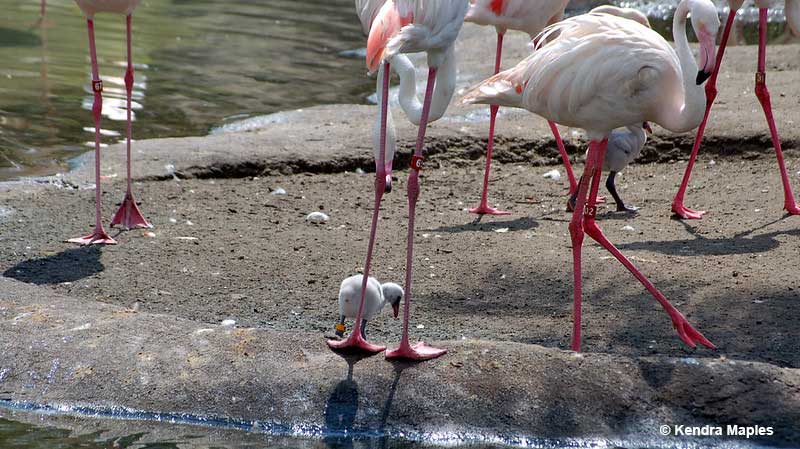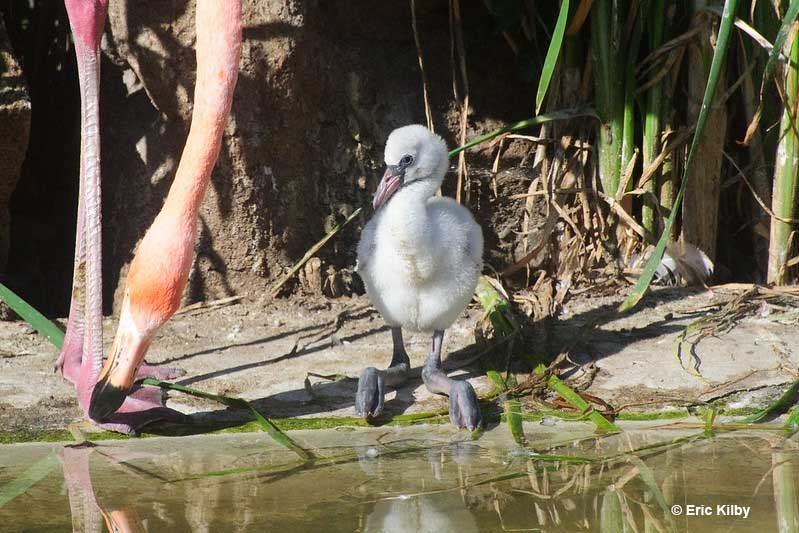
Baby flamingos don’t start their lives as flamboyant as their parents. However, they are similarly eccentric. After all, they hatch on the top of a mud volcano and sustain themselves on the blood-red crop milk.
These are just some unusual facts about baby flamingos. Read on to find out more details on why these fiery birds build their nests out of mud, how they gain the pink color after hatching all grayish, and what the “flamingo kindergarten” is called.
On this page
Flamingo’s Muddy Nest
Unlike the majority of birds that build nests using some plant material, flamingos take a different approach, as observed in some marine and aquatic birds. They build mound-shaped nests out of mud.
The female picks a spot on a mudflat, and then both male and female continue to build the nest by scraping the soil with their beaks and adding it to the growing bell-shaped heap. The nest takes several days to complete.
The final product looks like a miniature earth vulcano (made by a preschooler). It is a cone-shaped muddy heap, about 30 cm high, with a scooped-out top.
As said, most of the mound is built by simply moving the mud in the bill and piling it, but expecting flamingo parents show an extra bit of craftsmanship by adding finishing touches using their feet.
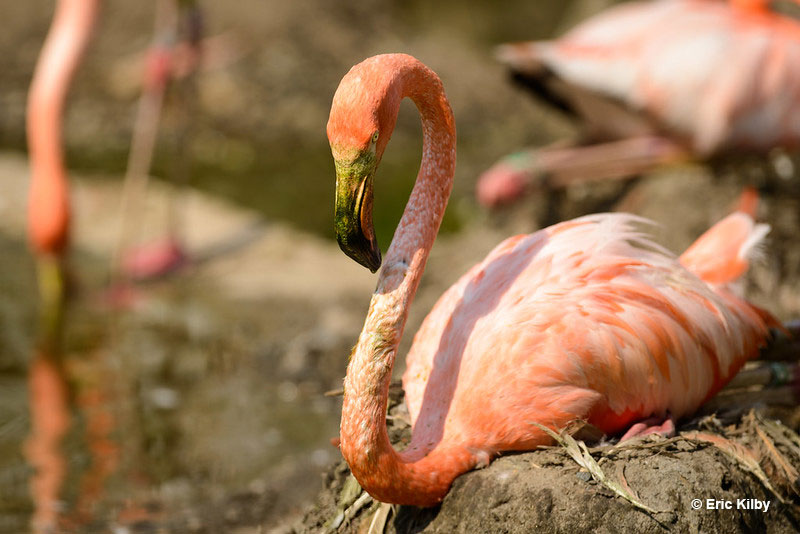
Mound nests provide the benefit of keeping the flamingo babies safe from sudden high waters and floods. Also, it is a protection against excessive heat radiating from the sunny mudflat.
As for the cons, mounds can house a limited number of offspring – and flamingos usually lay only one egg.
Despite being a single chick in the nest, a baby flaming will not grow up alone because flamingos are colonial nesters. For example, American Flamingo populations must form colonies of at least 50 for a successful nesting season.
In reality, the colonies often have hundreds of nests. The only exceptions are Galapagos flamingo populations that breed in groups containing between 5 and 10 pairs on average.
Flamingo Eggs
The female flamingo most commonly lays a single, large egg. Laying two eggs does happen from time to time, but it’s rare.
The flamingo egg is oblong and matt (lusterless) white, weighing about 115 grams.
If you’ve ever seen a bluish flamingo egg, the truth is that it may have a pale blue tint right after laying, turning entirely white later. However, pinkish flamingo eggs do not exist, despite what you may find on the internet.
Egg incubation starts as soon as the female lays it. Both parents take turns at sitting on the mound for about 30 days (or 27 to 31 days, to be precise).
Parents periodically gently lift and turn the egg with their conveniently shaped bills. However, despite being such careful parents, if the egg rolls out of the nest, they won’t even try to retrieve it (at least according to currently available observations and sources).
What Does a Baby Flamingo Look Like?
Flamingos are altricial, meaning that their babies hatch underdeveloped and need extensive care from their parents.
Baby flamingos are very unlike the showy adults. In fact, excluding the strong, long legs and elongated necks, they barely resemble their parents.
Flamingo chicks hatch covered with short but thick, soft, dirty-white feathery down. You can recognize the freshly emerged chicks in a colony because they remain wet several hours after hatching.
After hatching, a baby flamingo remains nest-bound for several days, sitting with either the mother or father for the first week of its life.
The chicks first leave the nest after 5-8 days. Gradually, they start moving around independently and form miniature flocks with other chicks. Also, they slowly begin taking on some adult characteristics. Their body proportions become very much like those of adults.
The beaks will start curving and developing the filtration system for independent feeding at about two weeks. This is a preparation for independent feeding.
At around three weeks, parents start purposefully herding the baby flamingos into special fledgling flocs, traditionally called crèches, to get them used to foraging for food in a group.
You can view crèche as a flamingo kindergarten or school. It can contain hundreds or even thousands of fledglings, and a small number of adults care for all these chicks.
When Do Flamingo Chicks Become Pink?
Believe it or not, it will take several years before young flamingos gain the trademark pink color. Once they complete their physical and color development, they also become sexually mature. Full maturity happens at 3-5 years of age.
Around 30% of juvenile flamingos don’t make it through their first year. Still, if they’re lucky, they may have a lifespan of over 30 years.
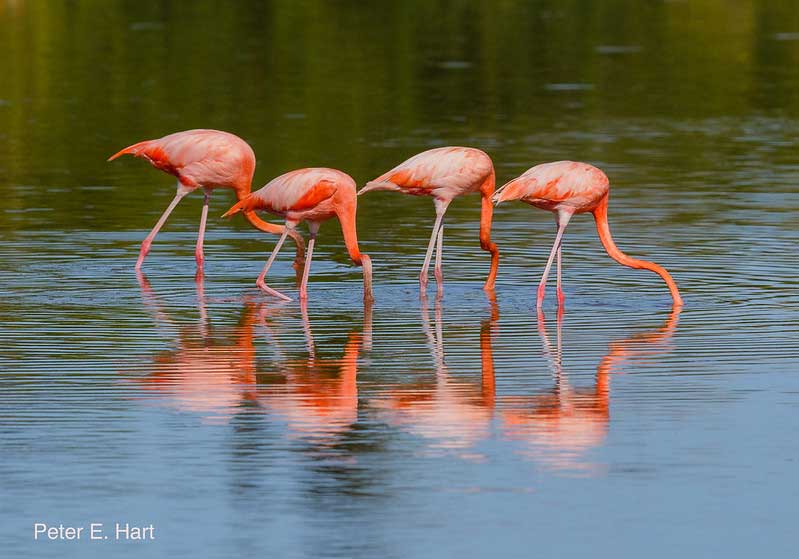
What do Baby Flamingos Eat?
From hatching and for the next couple of months, adults will feed their chicks with “crop milk” dripping from their bills.
‘Crop milk’ is a specially secreted substance and not regurgitated food from the crop as commonly thought. Instead, it is secreted from specialized glands that line the upper digestive tract.
Nutrient content is similar to regular milk, containing lipids, proteins, and sugar (glucose). Even the same hormone, prolactin, is involved in the secretory mechanism. However, in flamingos (and birds in general), both parents secrete crop milk to feed the chick.
The “milk” has a deep red color that stems from carotene-rich food that flamingos consume. These include tiny organisms from cyanobacteria to tiny crancrustaceans that live in the water of flamingo habitats. The birds catch them with their filtering apparatus.
Carotene accumulating in the tissue is what gives flamingos their color.
Baby flamingos start to independently forage when they are around a month to a month and a half old. However, parents will continue feeding them until they are fully fledged at 9-13 weeks of age. It is no wonder since filter feeding is a time-consuming practice. For example, the Lesser Flamingos spend nearly 70% of their day feeding!
How to Tell Baby Flamingos Apart
There are slight variations in color among the six species of flamingos. However, they all develop in a similar manner, going through several stages of morphological and color development.
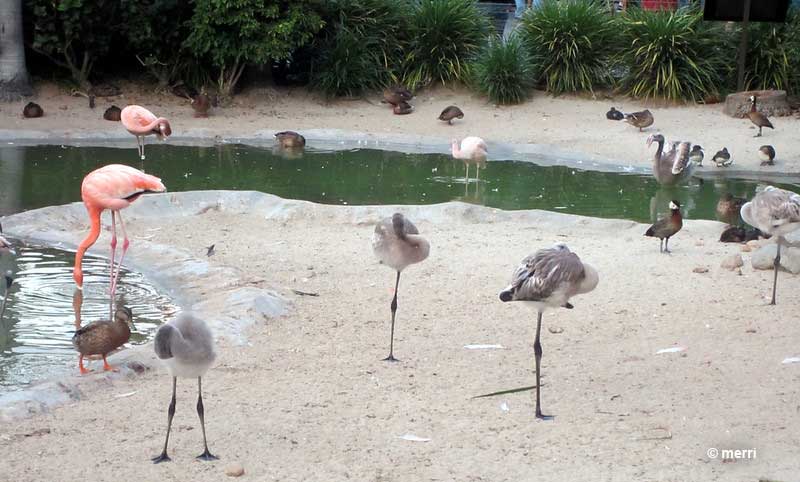
These young juveniles are not too old, maybe nearing the one-year mark. © merri
Here is how it goes with the American Flamingo.
- Hatchlings and nestlings have grayish-white downy plumage.
- At about 4 weeks of age, the light downy feathers turn dark gray.
- At 6-10 months, the downy feathers give way to normal whitish-gray feathers; the primaries are black. The bill becomes light pink with a characteristic black tip. Legs begin turning pink.
- In young subadults (around 1 year old), plumage starts turning pinkish, with the wings containing most of the new coloration. Also, the neck’s base will often turn orange first, providing a collar visual effect.
- This pale pink will become the well-known “flamingo pink” as the young bird approaches adulthood.
- It can take up to 5 years for an adult flamingo to reach its full color, provided they’re feeding properly.
Bonus: Interesting Facts on Baby Flamingos
- Flamingos build nests in a colony very close to each other, often causing loud (but harmless) squabbles about personal space.
- Sometimes, flamingos will add other materials, such as sticks and feathers, to their nests. On islands with no soil or mud available, flamingos can build their nesting mounds from stones.
- The noun used for juvenile flamingo flocks – the Crèche – comes from the French word for ‘crib.’
- If baby flamingos fall out of their nest before moving independently, the parents won’t pull them back onto the mound. Instead, they will protect and feed them on the ground at the nest’s base.
- Surprisingly, if a predator attacks a juvenile group, adults will not defend their offspring. Instead, they will simply run for their own lives. Still, after the danger subsides, they will call out to find their own chick.
- Watching baby flamingos learning how to swim is just adorable.
Frequently Asked Questions
Why are baby flamingos not pink?
Baby flamingos are usually white or gray, which comes from the lack of pigment. As they grow older and their feathers molt, they start looking more and more like our beloved flamingos.
Do flamingos feed their babies’ blood?
Flamingos do not feed their young ones blood; it’s actually crop milk. This comes from their diet – their carotene-rich food gives the parents their unique colors as well!

